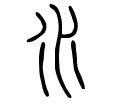The Shell Bone Script for character Eternal
The middle part resembles a person
with streams on either side. Ancient people saw long rivers flowing from distant places, heading towards unreachable, eternal destinations. Rivers flow continuously and eternally without interruption, so they believed this was 'eternity'. If a person immersed themselves in the river, they could merge with the river and attain 'eternal life'. The idea of 'being with mountains and rivers, shining with the sun and moon' embodies 'eternity'.
The Bronze Script for character Eternal
Similar to the Shell Bone Script.
The Small Seal Script for character Eternal
The middle part is a person, and streams flow on either side.
This character closely resembles the character for character water
The difference is that the middle part of character Eternal is a person, but character Water is a bent line for water flow. The sides for both characters are water flow.
The Clerical Script for character Eternal
The middle part is not like a person anymore, the sides are not like water flow too. Without understanding the evolution of Chinese characters, one cannot deduce this meaning. Therefore, studying pictographic Chinese characters must be combined with their evolution to understand their origins and development.
The character for 'eternal' also closely resembles the character for 'water'.
Let's see character Far.
The Shell Bone Script for character Far
It looks somewhat complex, but it is actually quite simple. On the right is half of an intersection, which refers to a road. The upper and middle parts on the left are the character for 'clothing', while the bottom part is the bronze script for 'clothing', which closely resembles the surrounding parts of the upper left.
Bronze script of character Cloth
Shell Bone script of character Road or Travel
In the Shell Bone Script for 'far', the circle in the middle of the 'clothing' character represents the body, the bearer of the clothing. The crossed lines at the lower right of the 'clothing' character represent 'hand'. The Shell Bone Script for 'far' thus signifies 'traveling with clothing'. If the distance is short and you can return the same day, you wouldn't need to carry extra clothes. If it takes several days, you need to bring clothes, implying a long distance travel.
The Bronze Script for character Far
The double-person radical on the left means 'road', similar to the right part in the Shell Bone Script, now placed on the left. The upper and lower parts on the right are 'foot',
The Bronze Script for character Foot
the middle of the character Far is 'clothing'. Here, there is no 'hand', but there are two feet, emphasizing walking and the need to carry clothes for a long distance.
The Small Seal Script for character Far
The three curved lines at the upper left represent 'road', similar to the double-person radical in the Bronze Script. Below is 'foot', and the upper right is another 'foot', though it doesn't resemble much. The lower right is 'clothing', indicating the need to carry clothes for a long-distance journey.
The Clerical Script for character Far
The bottom part signifies 'related to walking', derived from the left part of the Small Seal Script. Some Clerical Script versions depict the bottom with three dots followed by a connection below (see the 'walking radical' section). The upper right part is a transformed 'foot', and the middle and lower parts are 'clothing'.
Simplified Song Typeface for character Far
In the simplified character for 'far', the character 元 apart from indicating pronunciation, has no other meaning. It also lacks the top dot and a short horizontal stroke, lost the pictography completely.
Understanding 'eternal' and 'far': for ancient people, 'eternity' meant a distance beyond needing to carry clothes, akin to a river flowing continuously forward, never stopping, reaching a place that can never be attained.
Eternal : endless time; Far: endless distance, they are together to mean Forever, ancient Chinese believed.
































































